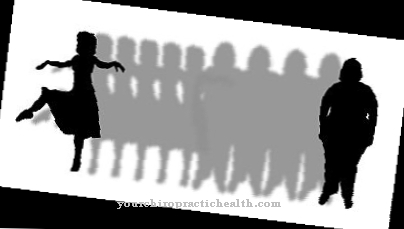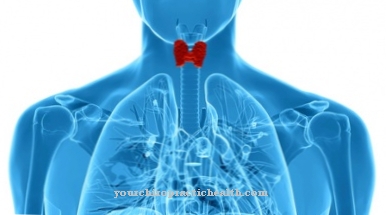Hyperactivity can have different causes. These are usually included in the choice of a suitable treatment.
What is hyperactivity?

The hyperactivity often affects children (boys more often than girls). In medicine, hyperactivity is defined as a symptom that can be associated with various mental or physical illnesses. Not every child who has a pronounced urge to move is automatically hyperactive; Hyperactivity in the strict sense is a medical diagnosis.
Hyperactivity in children is often accompanied by impaired concentration; this is the case, for example, with what is known as attention deficit / hyperactivity disorder (ADHD).
Although hyperactive children are easily distracted and often behave restlessly in school, for example, their intelligence is usually no less than that of children who do not suffer from hyperactivity.
causes
The causes of an existing hyperactivity cannot always be clearly determined. Hyperactivity can be caused, for example, by mental illnesses such as depression or autism (a developmental disorder that manifests itself, among other things, through restricted interpersonal communication and stereotypical behavior).
Physical illnesses can also lead to hyperactivity in those affected. These diseases include hyperthyroidism or the so-called Angelman syndrome - while hyperthyroidism is an overactive thyroid, Angelmann syndrome is a congenital gene mutation.
You can find your medication here
➔ Medicines to calm down and strengthen nervesDiseases with this symptom
- autism
- Asperger syndrome
- Affective disorders
- Angelman Syndrome
- ADHD
- Hyperthyroidism
Diagnosis & course
The diagnosis of hyperactivity is not always easy to make, as the boundaries between active and, in the medical sense, hyperactive child are often blurred. Experts make a corresponding diagnosis, among other things, on the level of behavioral observations and descriptions of the caregivers and on the basis of the results of various psychological test procedures.
If there is a suspicion of physical illnesses as the cause of hyperactivity, this can be checked using medical test procedures. Hyperactivity has to be distinguished from a merely high urge to move, as it is caused, for example, by complaints such as restless legs syndrome (a neurological disease).
Hyperactivity can manifest itself in those affected as early as babies or toddlers; For example, hyperactive toddlers tend to show a relatively low level of risk awareness when they are more willing to experiment. Hyperactivity that is not due to a physical illness often subsides or disappears with the onset of puberty. In some cases, however, those affected still suffer from occasional hyperactivity in adulthood.
Complications
Hyperactivity is usually diagnosed as part of ADHD (attention deficit hyperactivity disorder) in children and adolescents. In kindergarten, those affected usually show difficulties in concentrating on an occupation. Children also often exhibit a delay in language development, so that communication is impaired.
In school, affected children usually have problems following the lesson; they are overwhelmed by the demands on calmness and concentration. The performance in school is accordingly significantly impaired. In addition to the individual school subjects, the fine motor skills are usually disturbed, so that the handwriting is unclean.
In addition, there may be an impairment of social life, since those affected usually also attract attention through their aggressiveness. The social isolation leads to the development of psychological problems in the following years up to adulthood. Due to the constant restlessness, those affected tend to lead a risky way of life.
The likelihood increases when the person concerned turns to alcohol and other drugs in adolescence. The addiction problems can progress into adulthood. Those affected tend to develop depression and delinquency. Concentration difficulties also severely limit the adult life at work and in the family.
Everyday life seems unstructured and totally haphazard. The impulsiveness can also affect the partner. The partner can be injured and the partnership broken by fits of rage of the person concerned.
When should you go to the doctor?
A weak hyperactivity is not easy to recognize. Mostly it concerns children, but adults can also be affected, for example after taking new medication. Anyone who has the feeling that their children are more restless than others should take them to the pediatrician or family doctor. Adults ready to face the diagnosis go to the family doctor first.
Temperament and energy are different from hyperactivity. A lively child may not be challenged enough or need more fresh air to let off steam. The doctor diagnoses hyperactivity based on typical parameters. If you are unsure whether to see a doctor, first ask people around you. When it comes to children, a discussion with educators in kindergarten or with the teachers helps. For adults, a sure instinct is required. Other people will certainly notice that those affected have changed.
A good family doctor takes a close look at his patient - whom he has known for years in the best case scenario - before referring him to specialists. If specialists quickly discover hyperactivity and immediately administer heavy medication, caution is advised, especially with this issue. A thorough investigation is a priority. On the other hand, over-the-counter medication should not be taken without medical advice.
Doctors & therapists in your area
Treatment & Therapy
Treatment for hyperactivity depends, among other things, on the underlying factors. In the case of hyperactivity, which is caused by a physical illness, the treatment goal is usually initially to treat the underlying illness. The hyperactivity that occurs can often be positively influenced by successfully controlling the underlying disease.
If hyperactivity occurs in the context of attention deficit / hyperactivity disorder (ADHD), the need for treatment is usually checked first. If appropriate treatment is to take place, the treatment plan is usually tailored to the patient concerned.
The therapy of hyperactivity in the context of ADHD usually comprises different aspects: If children or adolescents are affected, not only the adolescents but also the caregivers and caregivers (such as teachers) are informed about the main features of the disease and how to deal with it.
Special training courses can make it easier for caregivers to deal with hyperactivity. As part of psychotherapeutic measures, a person affected can also learn to better control or redirect hyperactivity.
Finally, in severe or moderately severe cases, an additional therapy component can be given to treat hyperactivity. Corresponding drugs usually affect metabolic processes in the brain.
Outlook & forecast
Usually children are particularly affected by hyperactivity, but adults can also suffer from this symptom. The main characteristic of hyperactivity is disorders of concentration. The affected people are unable to concentrate at work or at school and show poor performance. It is therefore relatively difficult for people with hyperactivity to lead a regular everyday life and regularly visit a job.
It happens relatively often that people develop hyperactivity and that it disappears on its own even without treatment. Whether this actually occurs depends heavily on the social environment of the person concerned and their general psychological and physical condition. People who have had hyperactivity since birth can usually not be completely cured. The symptom is often treated with medication, which does not completely solve the problem, but only curb the hyperactivity. These drugs have to be taken over and over again in order to be able to lead an ordinary everyday life.
The rest of the treatment is psychological and is primarily aimed at the causes of the hyperactivity, if it is not genetic or caused by harmful substances. Whether a treatment for hyperactivity will be successful cannot be universally predicted.
You can find your medication here
➔ Medicines to calm down and strengthen nervesprevention
Since the causes of hyperactivity cannot always be clearly defined, prevention is hardly possible. However, if symptoms of hyperactivity appear, an early visit to the doctor can contribute to the early start of medical and / or psychological measures. This can help prevent symptoms and / or social problems caused by hyperactivity from worsening.
You can do that yourself
Since sugar consumption may lead to hyperactivity, a low-sugar diet is worth trying. In particular, sweets, sweet pastries and sugary drinks are reduced. In addition, a healthy and balanced diet also seems to have a positive effect on the internal state of arousal.
Clear structures are very important in everyday life with hyperactivity. This includes fixed times for sleeping and getting up, regular meals and regular activities. In the evening in particular, bedtime rituals can help calm down before going to sleep. This applies not only to hyperactive children but also to adults. A low-irritant environment can be advantageous, particularly when sleeping. Other people living in the same household can contribute to this structuring. In the case of adolescents and adults in particular, however, it often makes sense to set limits so that the person concerned does not feel patronized or other people use the situation to disproportionately control the person concerned.
Relaxation procedures also contribute to self-help. Autogenic training, progressive muscle relaxation, meditation and mindfulness train inner perception, reduce physical and psychological tension and promote the ability to reflect.

















.jpg)







.jpg)


